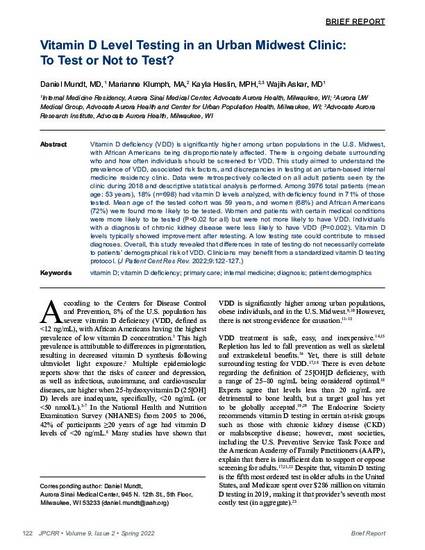
- vitamin D,
- vitamin D deficiency,
- primary care,
- internal medicine,
- diagnosis,
- patient demographics
Vitamin D deficiency (VDD) is significantly higher among urban populations in the U.S. Midwest, with African Americans being disproportionately affected. There is ongoing debate surrounding who and how often individuals should be screened for VDD. This study aimed to understand the prevalence of VDD, associated risk factors, and discrepancies in testing at an urban-based internal medicine residency clinic. Data were retrospectively collected on all adult patients seen by the clinic during 2018 and descriptive statistical analysis performed. Among 3976 total patients (mean age: 53 years), 18% (n = 698) had vitamin D levels analyzed, with deficiency found in 71% of those tested. Mean age of the tested cohort was 59 years, and women (68%) and African Americans (72%) were found more likely to be tested. Women and patients with certain medical conditions were more likely to be tested (P < 0.02 for all) but were not more likely to have VDD. Individuals with a diagnosis of chronic kidney disease were less likely to have VDD (P = 0.002). Vitamin D levels typically showed improvement after retesting. A low testing rate could contribute to missed diagnoses. Overall, this study revealed that differences in rate of testing do not necessarily correlate to patients’ demographical risk of VDD. Clinicians may benefit from a standardized vitamin D testing protocol.
Mundt D, Klumph M, Heslin K, Askar W. Vitamin D level testing in an urban Midwest clinic: To test or not to test? J Patient Cent Res Rev. 2022;9:122-7. doi: 10.17294/2330-0698.1854
